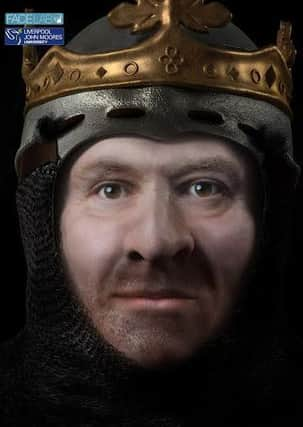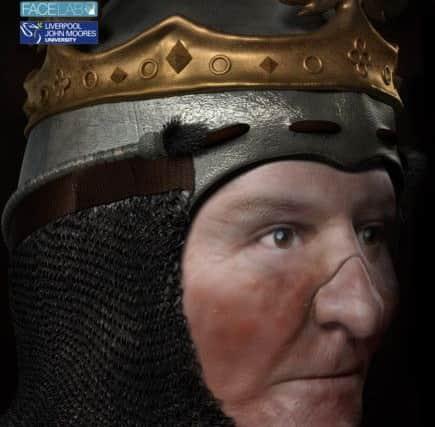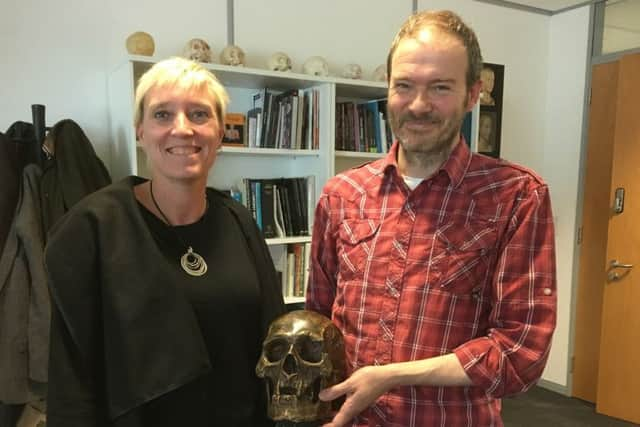Face of Robert The Bruce finally revealed ...


A new BBC ALBA documentary, Ceann an Rìgh/The King’s Head, will reveal the face of Robert the Bruce as it follows the work of Britain’s leading expert on craniofacial reconstruction as she uses cutting edge digital technology to create a 3-D portrait of King Robert.
Professor Caroline Wilkinson of Liverpool John Moores University – who was responsible for re-creating the face of Richard III from his skull after his body was discovered buried underneath a car park in Leicester – has used a plaster-cast of Bruce’s skull to base the portrait on. The muscles and tissues of the face are then added to the skull, using her knowledge of anatomy.
Advertisement
Hide AdAdvertisement
Hide AdProfessor Wilkinson said: “The finished head is really a very strong, robust looking male. He’s got a very strong neck, big shoulders, someone who’s used to physical activity. The other thing that’s come out of it is that he’s got quite a strong jawline.


“The muscle attachments on the skull suggest that he had very strong, well-built muscles which means that he was using them a lot and from that period of time we can assume that means he was quite a physical individual either doing heavy manual labour or involved in fighting.”
Bruce has been depicted for centuries in paintings, sculptures and films – without anybody actually knowing what he looked like. The quest to reveal his face was launched by Dr Martin MacGregor, a historian at the University of Glasgow. Martin has been obsessed with Bruce for decades and was inspired by Caroline Wilkinson’s work on other historical figures, including Robert Burns and Mary Queen of Scots.
Scientists and historians have joined forces to create detailed virtual images of what could be the head of Robert the Bruce, reconstructed from the cast of a human skull held by the Hunterian Museum.
Advertisement
Hide AdAdvertisement
Hide AdThe realistic images are the outcome of a collaboration between historians from the University of Glasgow and craniofacial experts from Liverpool John Moores University (LJMU).


One image depicts the subject in his prime, a large and powerful male head that would have been supported by a muscular neck and stocky frame – a match for the super-athletes of today.
Robert Bruce, hero-king of Scots from 1306 until his death in 1329 aged around 55, was no stranger to the battlefield. He waged war to wear down his Scottish opponents and the English regime in Scotland, culminating in the battle of Bannockburn in 1314.
However, another image reveals that strength co-existed with frailty. The skull exhibits likely signs of leprosy, disfiguring the upper jaw and nose.
Advertisement
Hide AdAdvertisement
Hide AdHistorians believe Bruce suffered from an unidentified ailment, possibly leprosy, which laid him low several times during his reign, and probably killed him. In Ulster in 1327, he was said to be so weak that he could only move his tongue.


The project to put a face to the Hunterian skull was led by Dr Martin MacGregor, a senior lecturer in Scottish history at the University of Glasgow. Dr MacGregor was inspired by the discovery of the skeleton of King Richard III of England beneath a car park in Leicester in 2012.
He said: “I was aware of previous attempts to recreate the face of the skull linked to Robert the Bruce.
“The case of Richard III revealed how far the technology had advanced. I saw an opportunity to apply the technology to the Hunterian skull held here at Glasgow: first to test the credibility of its connection to Bruce, and then to try to add to our knowledge of Scotland’s greatest king.”
Advertisement
Hide AdAdvertisement
Hide AdDr MacGregor requested the expertise of Professor Caroline Wilkinson, director of LJMU’s Face Lab and a world-renowned craniofacial identification expert, to carry out the facial reconstruction of Robert the Bruce.


Professor Wilkinson said: “Using the skull cast, we could accurately establish the muscle formation from the positions of the skull bones to determine the shape and structure of the face. But what the reconstruction cannot show is the colour of his eyes, his skin tones and the colour of his hair.
“We produced two versions – one without leprosy and one with a mild representation of leprosy. He may have had leprosy, but if he did it is likely that it did not manifest strongly on his face, as this is not documented.”
No reliable visual depictions of Robert the Bruce were made in his own time, and written records tell us nothing about his appearance. DNA would offer another way to establish hair and eye colour – but there is a problem.
Advertisement
Hide AdAdvertisement
Hide AdDr MacGregor said: “The skull was excavated in 1818-19 from a grave in Dunfermline Abbey, mausoleum of Scotland’s medieval monarchs.
“After the excavation the original skeleton and skull were sealed in pitch and reburied, but not before a cast of the head was taken. Several copies of the cast exist, including the one now in The Hunterian, but without the original bone we have no DNA.”
Professor Wilkinson added: “In the absence of any DNA, we relied on statistical evaluation of the probability of certain hair and eye colours, conducted by Dr MacGregor and his team, to determine that Robert the Bruce most likely had brown hair and light brown eyes.”
“This is the most realistic appearance of Robert the Bruce to-date, based on all the skeletal and historical material available.”
Ceann an Rìgh/The King’s Head has been produced by Caledonia TV for BBC ALBA and will be broadcast on Thursday, December 15 at 8.30 – 9.00pm.